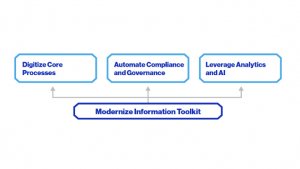
At best, organisations have been able to keep pace with this rising tide. At worst, they are falling behind and putting their long-term survival at risk. In early 2018, the information management industry association, known as AIIM, set out to quantify the situation and ascertain how information managers are coping with this ‘information chaos’. Feedback from over 100 respondents in Europe and North America who will need to address this challenge suggests that the scale and nature of content management challenges have changed.
The problem is not only that content is scattered — it’s also ‘big’. Organisations are also faced with the need to manage an increasing volume, variety, and size of content assets — in short, ‘Big Content.’ Addressing Big Content is a prerequisite to not just surviving, but thriving in the Information Age.
Content Chaos is Proliferating
The increasing volume of incoming information and the speed at which organisations must ingest this information is well-documented. But often under-appreciated is the sheer size of the files that must be managed:
- Think about how the average image size on your phone has increased over the past five years.
- There are more digital file types (videos, images, audio files) than ever before, creating ongoing information governance challenges.
- This is especially the case since these digital or rich media files are now core business assets that must be treated accordingly and often managed over long retention periods.
These are the kind of digital asset management challenges that media and entertainment companies have struggled with for a number of years. These issues are no longer unique to those industries — every industry faces them.
Much more, we find data and content everywhere — in spreadsheets, line-of-business applications, in-house developed systems, file sharing apps, in network folders, in cloud file shares, in ERP and CRM systems, and in emails. As a consequence, information overload is the norm for most organisations, not the exception.
Massive amounts of data and content often resides within multiple and disconnected platforms, applications, locations, and devices. This ‘Big Content’ conundrum creates compliance and security risks. It also leaves employees with only some of the information they need to perform their jobs.
AIIM Studies the kinds of problems Big Content creates
One issue AIIM uncovered in its research is it’s increasingly difficult for information workers to find what they need. The top four challenges were:
- Finding the right information in a timely way is a problem (76%)
- Information overload (75%)
- The cost and/or difficulty of managing legacy applications (65%)
- Compliance regulation (e.g., GDPR, HIPAA) features as a problem for 64%
The second area AIIM’s researchers explored was usability. The key issues here are:
- Most organisations say they experience difficulty sharing information and content with colleagues, customers, suppliers and partners (63%)
- Mobile access issues (58%)
- ‘Usability by the average worker’ (74%)
AIIM also asked how easily practitioners could integrate information across systems. The answers were not at all easy. The reasons given were:
- Inability to connect information from different systems (79%)
- Scaling our information management systems to other processes beyond the original deployment (71%)
- A lack of integration between content management system and core business applications (74%)
Practical ways to get out of the Big Content impasse
If you agree that these problems are worrying, what is the call to action? How should you go about preparing your organisation to deal with Big Content? A modern information management strategy is a critical part of this equation – and so are modern Content Services Platforms (CSPs).
That’s because a CSP is the foundation for a modern information management system, as it’s not something built 10 years ago in a time before mobile and cloud had taken off. That means it can natively manage all of today’s data and content types — video, audio, social media, etc.— not just scanned documents and Word files.
A CSP can act out of the box as an information hub. This is not just for data and content stored within the CSP, but also for information stored in multiple (legacy) systems throughout the business. That is very key, as a CSP provides business users with a single place to go to in order to store and retrieve information, which for large enterprises could be billions of items.
As AIIM concludes: “In the old days of much narrower (albeit mission-critical) ECM solutions, ECM was the straw the stirred the process drink. But it’s the other way around now, and that’s what Content Services is all about.”
Without CSP, then — or technology like it — organisations will continue to struggle with solutions that were fine for yesterday’s problems, but not for today’s challenges — let alone tomorrow’s.
The author is VP of Product Marketing at Content Services platforms supplier Nuxeo
Download the AIIM report discussed in the article here
Nuxeo, developer of the leading, cloud-native Content Services Platform, is reinventing enterprise content management (ECM) and digital asset management (DAM). Nuxeo is fundamentally changing how people work with both data and content to realise new value from digital information. Its cloud-native platform has been deployed by large enterprises, mid-sized businesses and government agencies worldwide. Customers like Verizon, Electronic Arts, ABN Amro, and the Department of Defense have used Nuxeo’s technology to transform the way they do business. Founded in 2008, the company is based in New York with offices across the United States, Europe, and Asia. Learn more at www.nuxeo.com.
























